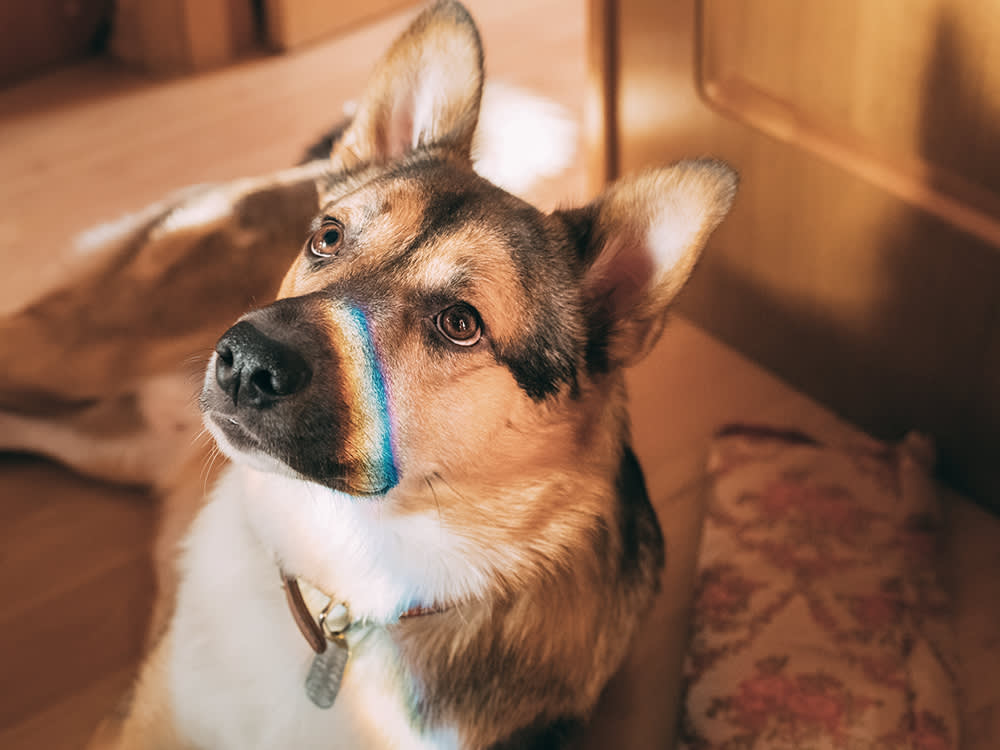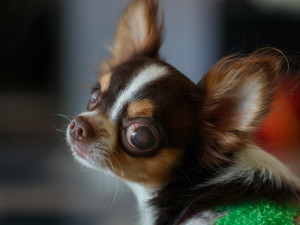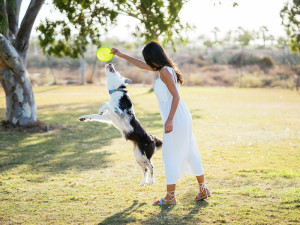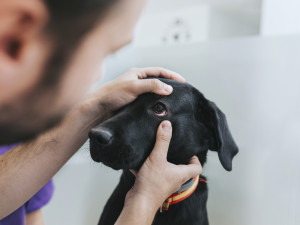What Colors Can Dogs See?
They can’t take in as many colors as you can, but their world isn’t just black and white.

share article
In This Article:
Are Dogs Colorblind?opens in a new tab The Science Behind Canine Color Visionopens in a new tab What Colors Can Dogs See Best?opens in a new tab What Colors Can Dogs Not See?opens in a new tab Training and Communicating with Colorsopens in a new tab Fun Facts About Dogs and Coloropens in a new tab
From vibrant sweatersopens in a new tab to toys in every color, pup parents often love choosing new items for their dogs. But how many of the colors on your pup’s favorite toy can they actually see? You’ve likely heard that dogs are color blind or even that they see the world only in black and white, but the reality is a little more complex. While dogs are able to see color, they have a more limited color-vision spectrum compared to humans, and those bright colors on their toys and bedding are more muted to their eyes.
So, what colors does a dog see? The truth about your dog’s vision may surprise you — and give you a little more appreciation for the way they navigate the world.
Are dogs colorblind?
Whitney, my seeing eye dog, and I visited a school on the North Side of Chicago recently, and for some reason, the first and second graders seemed particularly interested in color blindnessopens in a new tab. When one of them asked me if it’s true that dogs can only see black and white, I explained that dogs do see some colors, but they can’t tell the difference between red and green.
“If we’re at an intersection with a stoplight, it’s my job to judge when it might be safe to cross,” I said. I described the way I stand up straight, concentrate, and listen for the rush of cars. When it sounds like the traffic is going in the direction I want to go, I take a guess the light is green and give Whitney a cue to go forward. Whitney’s ears perk up; she listens for traffic and looks left and right to confirm it’s safe before pulling me across.
So, are dogs color blind? In a way, yes. A dog’s vision is similar to that of a human who has red-green color blindness. To dogs, red may appear gray or dark brown, while yellow, orange, and green all look like varying shades of yellow, and violet appears to be just another shade of blue.
Research is still ongoing to determine if dogs can distinguish between red and green perhaps based on the intensity of the light, and some scientists believe canines may also use context clues to tell the difference, such as understanding that red objects tend to be darker than green ones.
The science behind canine color vision
Why are dogs color blind? The reason for this more muted spectrum in dog color vision all comes down to the nerve cells in a dog’s eyes. Humans and dogs both have two main types of nerve cells, or photoreceptors, in their retinas: rods, which detect light and motion; and cones, which help differentiate colors.
Human eyes have more cones, allowing us to see a vibrant spectrum of color, while dogs can see just blue and yellow. This limited spectrum is known as dichromatic color visionopens in a new tab. But dogs have more rods than humans, which enables them to see better than we do in low light and to identify moving objects more easily.
How does a dog’s brain process colors?
Dog eyes work much like a camera. Light enters through the pupil. The iris, a structure that can expand and contract, controls the amount of light allowed in. Light then passes through the clear cornea and lens, which focus the light on the retina, a light-sensitive layer. The retina contains color-sensitive cones and motion- and light-sensitive rods, all of which convert light into electrical signals. The cones and rods send these signals via the optic nerve to the brain, which constructs an image from them.
Dogs have only two types of cones, compared with the three types in human eyes. As a result, dogs don’t distinguish as many colors as people do. A dog’s color spectrum is more muted, allowing them to distinguish blue, yellow, and various shades of gray. Dogs may also have difficulty distinguishing between different shades of the same color, like light blue and dark blue.
What colors can dogs see best?
So, how many colors can dogs see?
Blue and yellow
Since dogs only have two types of cones (aka dichromatic vision), they can only see blue and yellow.
Gray
Dogs can see shades of gray — but contrary to some misconceptions, they don’t only see gray. Some colors that dogs can’t see as well as blue and yellow may appear gray to them.
What colors can dogs see in the dark?
A unique feature of pup vision is that dogs can see pretty well in the dark. “When compared to humans, dogs can see better in the dark because they have larger pupils, more rod photoreceptors (the special cells that receive light), and a tapetum lucidum,” Dr. Alycia Washington wrote for usopens in a new tab. This night vision doesn’t change the colors they can perceive, though; their world of color remains limited compared to humans’.
The benefits of selecting blue and yellow toys
Because dogs can only see blue and yellow vibrantly, blue and yellow toys are ideal for keeping pups engaged.
What colors can dogs not see?
Dogs have a hard time distinguishing between some other colors.
Green
Dogs can’t see green well; it may appear a yellow color to dogs.
Red
Red may appear as dark brown or gray.
Orange
Like green, orange may look yellow to dogs.
Purple
To dogs, purple looks similar to blue.
Training and communicating with colors
Knowing how a dog’s vision works can enable pet parents to better train and communicate with their pups.
Using color cues
One way to incorporate your pup’s color perception into training is teaching your pup how to recognize different colors. Using blue or yellow toys, you can train your pup to associateopens in a new tab the cues “yellow” and “blue” with the correct color. This is a great exercise for in between longer training sessions — or just to add some mental stimulation to your pup’s life.
Adapting training methods to accommodate dogs’ visual abilities
If you’re training your dog to do an object-specific trick, such as picking up a leash, you may want to use a yellow or blue object so they can properly see it.
Dogs do better at agility trainingopens in a new tab when the weave poles, tunnels, jumps, and boards are painted in colors they can easily discern, such as blue and yellow.
Verbal commands and body language
At the end of the day, verbal cues and body language will be your best tool during training. Always use positive reinforcement trainingopens in a new tab and never punish or yell at your pup.
Can I use specific colors to attract or get a dog’s attention?
Dogs see blue and yellow best, but the best way to get a dog’s attention is to use movement and to stand right in front of them, as well as to invest in training to help them learn and respond to cues.
Fun facts about dogs and color
Although dog color vision is much more limited than that of their human parents, dogs tend to be very attentiveopens in a new tab to the colors they are able to perceive, and some evidence suggests that dogs may even be able to see some colors that humans cannotopens in a new tab.
Dogs are nearsighted.
Dog eyesight is 20/75, which makes them quite nearsighted. So, while your dog is likely better at detecting movement and seeing in dark rooms, their vision may be much blurrier than yours.
The best dog toy color is...
Based on what we know about dogs’ color vision, the best color for dog toys is blue, which will stand out on most backgrounds, such as grass, which only appears yellowish or brown to dogs.
FAQs (People also ask):
What color toys can dogs see?
Dogs can see blue and yellow. The best color for dog toysopens in a new tab is blue because it’ll stand out against grass.
Does a dog’s limited color vision affect their daily life?
Dogs are born with color blindness, so their limited color vision doesn’t have much of an impact on the way they go about their daily lives. However, dogs have trouble seeing red or pink, so try to avoid these colors when selecting new toys for your dog.
What age do dogs have vision problems?
Like humans, dogs can develop vision problems at any age and for many reasons. Common vision problems that occur with age, such as cataracts,opens in a new tab may be more likely in their senior years, which for most dogs is between nine to eleven years old depending on their size and breed.
What are the early signs of a dog going blind?
One of the most common physical signs of blindness in a dog is cloudy-looking eyesopens in a new tab as they age. You may also notice your dog acting more nervous or hesitant when moving around the house, jumping on and off furniture, or using stairs, especially in low light. Some dogs may even become more clingy or aggressive when they struggle to see.
References:

Beth Finke
Beth Finke is the author of Safe & Sound and winner of the ASPCA’s Henry Bergh award for children’s literature. Her most recent book is Writing Out Loud: What a Blind Teacher Learned from Leading a Memoir Class for Seniors.

Savannah Admire
Savannah Admire is a writer, poet, and pet mom to three dogs and a cat. She currently lives in Western Maryland. When she’s not writing, you can find her reading, taking photos, or volunteering as a content creator for her local community theatre. Her debut poetry book, Mother Viper, is due out August 12, 2025, and you can follow her on Instagram at @savannahcooperpoetopens in a new tab.
Related articles
![Cavalier King Charles Spaniel's eye is examined on the bed by a person]() opens in a new tab
opens in a new tabDogs Get Dry Eye Too...Some Breeds More Than Others
Eyes without tears are only for Cameron Diaz in The Holiday.
![Dark brown dog sitting on a gray couch in a living room]() opens in a new tab
opens in a new tabTurns Out Dogs Can Tell, Er, Smell Time
There’s no time like the present, according to your pet.
- opens in a new tab
What’s This Weird Red Bump On My Dog’s Eye?
That would be a cherry eye, and you’ll want to see your vet.
![Woman in vintage striped pants walking in park while her pet is following the trail. Cute beagle dog sniffs something on the path in morning.]() opens in a new tab
opens in a new tabDoes Your Dog Have a Nose For Scent Training?
This sounds like a competition show waiting to happen.
![Young woman looking at cellphone with her dog]() opens in a new tab
opens in a new tabDoes Your Dog Understand When You FaceTime Them?
It’s a nice thought.









